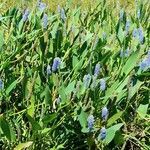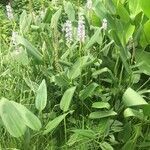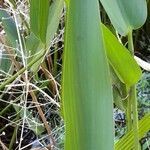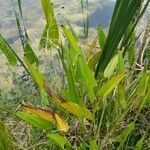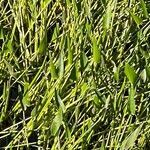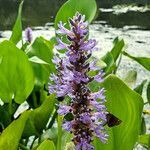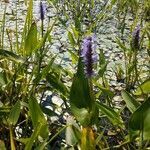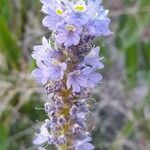Plant erect, emersed, up to 15 dm. tall, rooted in the mud. Petiole elongate, stipulate; leaf blade lanceolate, oblong-lanceolate, cordate, hastate, or sagittate, 3-20 cm. long, 2-15 cm. broad. Spathe loosely ensheathing the lower rachis, with inflorescence usually well exserted; inflorescence longer than broad, 3-13 cm. long; rachis and base of flowers lightly pubescent, sometimes glabrate in age, if glandular-pubescent the glands globular and less than 0.1 mm. in diameter. Flowers white to blue, 8-15 mm. long; tube 5-9 mm. long; stamens unequally adnate to the tube, the 3 lower not exserted beyond the tube; anthers orbicular or oblongoid, about 0.7 mm. long; filaments up to 9 mm. long; style elongate, about 8 mm. long, with a subcapitate, inconspicuously lobed stigma. Fruit oblong-pyriform or ovoid-pyriform, 4-7 mm. long, with longitudinal ridge-like crests.
A perennial herb. It is an erect plant which grows in water. It has underground stems or rhizomes. It grows 90-120 cm high and 60-75 cm wide. The leaves develop from the base and have long leaf stalks. The leaf blade normally sticks out of the water. The first leaves may be floating. The mature leaf blades may be 20 cm long and 10 cm wide. They can be heart shaped or sword shaped. There is a small leaf below the flowering stalk. This can clasp the stem. The flower is a spike like panicle. It is dense and 5-15 cm long. It is blue. The flowers have both sexes. The flowers are funnel shaped. The fruit are hard egg shaped capsules 5-10 mm long.
Plants to 130 cm high. Basal leaf lamina ovate to broadly ovate, obtuse, cordate, 8-22 cm long, 5-12 cm wide; petiole 40-60 cm long. Cauline leaf lamina similar; petiole shorter. Inflorescence dense, many-flowered, 5-11 cm long, 3-3.5 cm diam.; peduncle 10-24 cm long, glabrous below bract, villous above. Perianth 14-17 mm long, ±mauve with yellow blotch on upper lobe, villous externally; both lips 3-lobed. Filaments glandular-hairy; anthers c. 0.7 mm long, blue. Style sparsely glandular-hairy; stigma lobes bifid, papillate. Nutlet not seen in Australia but enveloped in hardened, tuberculate-ridged perianth base.
Plants perennial, rooted in mud. Vegetative stems contracted, rhizomatous. Flowering stems erect, to 120 cm. Sessile leaves: blade linear. Petiolate leaves emersed; stipule 7–29 cm; petiole distinctly constricted just below blade, to 60 cm; blade lanceolate to cordate, 6–22 × 0.7–12 cm. Spikes with up to several hundred flowers, 2–15 cm; spathes 5–17 cm. Perianth mauve, tube 3–9 mm, limb lobes oblanceolate, 5–8 mm, distal central lobe with 2-lobed yellow spot; proximal stamens 7–13 mm, distal 1.5–6.3 mm; style 3-lobed. Utricles with dentate ridges, 4–6 × 2–3 mm.
Erect or nearly so, to 10 dm; basal lvs and lower stem-lf similar, long-petioled, the blade firm, broadly cordate to lanceolate, to 18 cm; spathe loosely sheathing, 3–6 cm; infl crowded, 5–15 cm; perianth funnelform, villous or shortly glandular-pubescent in bud, later often glabrate, violet-blue, rarely varying to white, the tube 5–7 mm, the lobes 7–10 mm; filaments pubescent; fr 5–10 mm, longer to sometimes shorter than wide; 2n=16. Marshes and shallow water; N.S. to Ont. and Minn., s. to S. Amer. (P. lanceolata)
